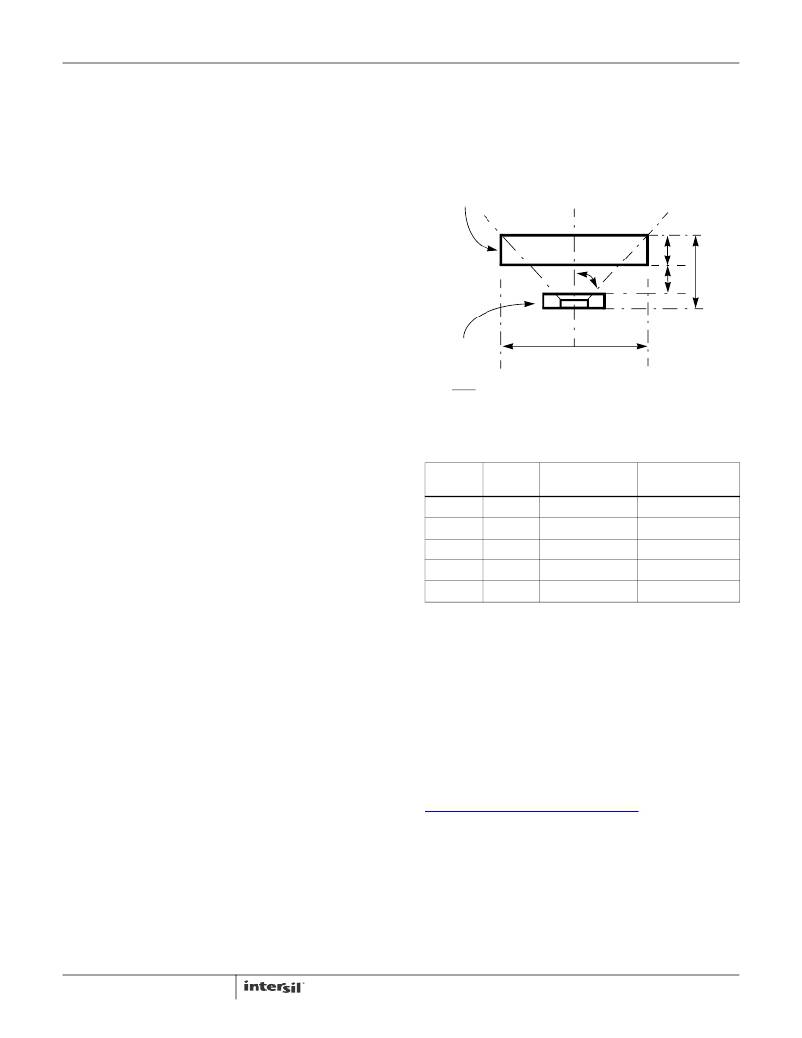- 您现在的位置:买卖IC网 > Sheet目录985 > ISL29010IROZ-EVALZ (Intersil)EVALUATION BOARD FOR ISL29010
�� �
�
 �
�ISL29010�
�INTEGRATION� TIME� IN� EXTERNAL� TIMING� MODE�
�This� timing� mode� is� programmed� in� the� command� register�
�00(hex)� Bit� 5.� External� Timing� Mode� is� recommended� when�
�integration� time� can� be� synchronized� to� an� external� signal�
�such� as� a� PWM� to� eliminate� noise.�
�To� read� the� light� count� DATA� output,� the� device� needs� three�
�sync_I� 2� C� commands� to� complete� one� measurement.� The� 1st�
�sync_I� 2� C� command� starts� the� conversion� of� the� diode� array� 1.�
�The� 2nd� sync_I� 2� C� completes� the� conversion� of� diode� array� 1�
�and� starts� the� conversion� of� diode� array� 2.� The� 3rd� sync_I� 2� C�
�pules� ends� the� conversion� of� diode� array� 2,� outputs� the� light�
�plastic� material.� A� thickness� of� t� =� 1mm� is� recommended� for�
�a� window� lens� design.� The� bigger� the� diameter� of� the�
�window� lens,� the� wider� the� viewing� angle� is� of� the� ISL29010.�
�Table� 12� shows� the� recommended� dimensions� of� the� optical�
�window� to� ensure� both� 35°� and� 45°� viewing� angle.� These�
�dimensions� are� based� on� a� window� lens� thickness� of� 1.0mm�
�and� a� refractive� index� of� 1.59.�
�WINDOW� LENS�
�t�
�count� DATA,� and� starts� over� again� to� commence� conversion�
�of� diode� array� 1.�
�?�
�D1�
�D� TOTAL�
�The� integration� time,� t� INT� ,� is� the� sum� of� two� identical� time�
�intervals� between� the� three� sync� pulses.� t� INT� is� determined�
�t� INT� =� ---------------�
�?� =� VIEWING� ANGLE�
�by� Equation� 12:�
�k� OSC�
�(EQ.� 12)�
�f� OSC�
�where� k� OSC� is� the� number� of� internal� clock� cycles� obtained�
�from� Timer� data� register� and� f� OSC� is� the� internal� I� 2� C�
�operating� frequency.�
�The� internal� oscillator,� f� OSC� ,� operates� identically� in� both� the�
�ISL29013�
�D� LENS�
�DATA�
�E=� x� 2000�
�2� 15�
�FIGURE� 4.� FLAT� WINDOW� LENS�
�TABLE� 12.� RECOMMENDED� DIMENSIONS� FOR� A� FLAT�
�WINDOW� DESIGN�
�internal� and� external� timing� modes,� with� the� same�
�D� LENS� @� 35�
�D� LENS� @� 45�
�dependence� on� R� EXT� .� However,� in� External� Timing� Mode,�
�the� number� of� clock� cycles� per� integration� is� no� longer� fixed�
�at� 2� n� .� The� number� of� clock� cycles� varies� with� the� chosen�
�integration� time,� and� is� limited� to� 2� 16� =� 65,536.� In� order� to�
�avoid� erroneous� lux� readings� the� integration� time� must� be�
�short� enough� not� to� allow� an� overflow� in� the� counter� register.�
�D� TOTAL�
�1.5�
�2.0�
�2.5�
�3.0�
�D1�
�0.50�
�1.00�
�1.50�
�2.00�
�VIEWING� ANGLE�
�2.25�
�3.00�
�3.75�
�4.30�
�VIEWING� ANGLE�
�3.75�
�4.75�
�5.75�
�6.75�
�t� INT� <� ------------------�
�65,535�
�f� OSC�
�(EQ.� 13)�
�3.5�
�t=1�
�2.50�
�Thickness� of� lens�
�5.00�
�7.75�
�f� OSC� =� 327kHz*100k� Ω� /R� EXT� .� When� Range/Gain� is� set� to�
�Range1� or� Range2.�
�D1�
�D� LENS�
�D� TOTAL�
�Distance� between� ISL29010� and� inner� edge� of� lens�
�Diameter� of� lens�
�Distance� constraint� between� the� ISL29010� and� lens�
�f� OSC� =� 655kHz*100k� Ω� /R� EXT� .� When� Range/Gain� is� set� to�
�Range3� or� Range4.�
�Noise� Rejection�
�In� general,� integrating� type� ADC’s� have� excellent�
�noise-rejection� characteristics� for� periodic� noise� sources�
�whose� frequency� is� an� integer� multiple� of� the� integration�
�time.� For� instance,� a� 60Hz� AC� unwanted� signal’s� sum� from�
�0ms� to� k*16.66ms� (k� =� 1,2...k� i� )� is� zero.� Similarly,� setting� the�
�device’s� integration� time� to� be� an� integer� multiple� of� the�
�periodic� noise� signal� greatly� improves� the� light� sensor� output�
�signal� in� the� presence� of� noise.�
�Flat� Window� Lens� Design�
�A� window� lens� will� surely� limit� the� viewing� angle� of� the�
�ISL29010.� The� window� lens� should� be� placed� directly� on� top�
�of� the� device.� The� thickness� of� the� lens� should� be� kept� at�
�minimum� to� minimize� loss� of� power� due� to� reflection� and�
�also� to� minimize� loss� due� to� absorption� of� energy� in� the�
�8�
�outer� edge�
�*� All� dimensions� are� in� mm.�
�Suggested� PCB� Footprint�
�It� is� important� that� the� users� check� the� “Surface� Mount�
�Assembly� Guidelines� for� Optical� Dual� FlatPack� No� Lead�
�(ODFN)� Package”� before� starting� ODFN� product� board�
�mounting.�
��Layout� Considerations�
�The� ISL29010� is� relatively� insensitive� to� layout.� Like� other�
�I� 2� C� devices,� it� is� intended� to� provide� excellent� performance�
�even� in� significantly� noisy� environments.� There� are� only� a�
�few� considerations� that� will� ensure� best� performance.�
�FN6414.1�
�November� 11,� 2011�
�发布紧急采购,3分钟左右您将得到回复。
相关PDF资料
ISL29011IROZ-EVALZ
EVAL BOARD FOR ISL29011
ISL29012IROZ-EVALZ
EVALUATION BOARD ISL29012IROZ
ISL29013IROZ-EVALZ
EVALUATION BOARD FOR ISL29013
ISL29015IROZ-EVALZ
EVALUATION BOARD FOR ISL29015
ISL29018IROZ-EVALZ
EVALUATION BOARD FOR ISL29018
ISL29020IROZ-EVALZ
EVALUATION BOARD FOR ISL29020
ISL29021IROZ-EVALZ
EVAL BOARD FOR ISL29021IROZ
ISL29023IROZ-EVALZ
EVALUATION BOARD ISL29023IROZ
相关代理商/技术参数
ISL29010IROZ-T7
功能描述:光学数位转换器 ISL29010IROZ LIGHT TO-DIGTL OUTPUT SENS RoHS:否 制造商:ams 数据总线宽度: 峰值波长:470 nm 最大工作频率: 工作电源电压: 工作电流: 最大工作温度:+ 85 C 最小工作温度:- 40 C 封装 / 箱体:Chipscale-6 封装:Reel
ISL29011IROZ-EVALZ
功能描述:EVAL BOARD FOR ISL29011 RoHS:是 类别:编程器,开发系统 >> 评估板 - 传感器 系列:* 产品培训模块:Lead (SnPb) Finish for COTS
Obsolescence Mitigation Program 标准包装:1 系列:-
ISL29011IROZ-T7
功能描述:IC PROXIMITY SENSOR AMB LT 8ODFN RoHS:是 类别:传感器,转换器 >> 多功能 系列:- 其它有关文件:Automotive Product Guide 标准包装:2,500 系列:- 传感器类型:光线和近程 输出类型:I²C?
ISL29011IROZ-T7R5484
制造商:Intersil Corporation 功能描述:ISL29011IROZ-T7 DOMINANT ASSY AND UNISEM TEST ONLY - Tape and Reel 制造商:Intersil Corporation 功能描述:IC PROXIMITY SENSOR AMB LT 8ODFN 制造商:Intersil Corporation 功能描述:ISL29011IROZ-T7 DOMINANT ASSY AND CARSEM TEST ONLY T/R
ISL29012IROZ-EVALZ
功能描述:EVALUATION BOARD ISL29012IROZ RoHS:是 类别:编程器,开发系统 >> 评估板 - 传感器 系列:- 产品培训模块:Lead (SnPb) Finish for COTS
Obsolescence Mitigation Program 标准包装:1 系列:-
ISL29012IROZ-T7
功能描述:IC SENSOR LIGHT-DGTL I2C 6-ODFN RoHS:是 类别:传感器,转换器 >> 光学 - 光电探测器 - 环境光传感器 系列:- 产品培训模块:Lead (SnPb) Finish for COTS
Obsolescence Mitigation Program 产品变化通告:Product Discontinuation 25/Jun/2012 标准包装:2,500 系列:- 带接近传感器:无 波长:- 电源电压:1.7 V ~ 2 V 电流 - 暗(标准):- 电流 - 光(典型值):- 输出类型:数字 - I²C 工作温度:-40°C ~ 85°C 安装类型:表面贴装 封装/外壳:6-UDFN 裸露焊盘 包装:带卷 (TR)
ISL29013IROZ
制造商:Intersil Corporation 功能描述:Light-To-Digital Sens,ISL29013IROZ
ISL29013IROZ-EVALZ
功能描述:EVALUATION BOARD FOR ISL29013 RoHS:是 类别:编程器,开发系统 >> 评估板 - 传感器 系列:- 产品培训模块:Lead (SnPb) Finish for COTS
Obsolescence Mitigation Program 标准包装:1 系列:-